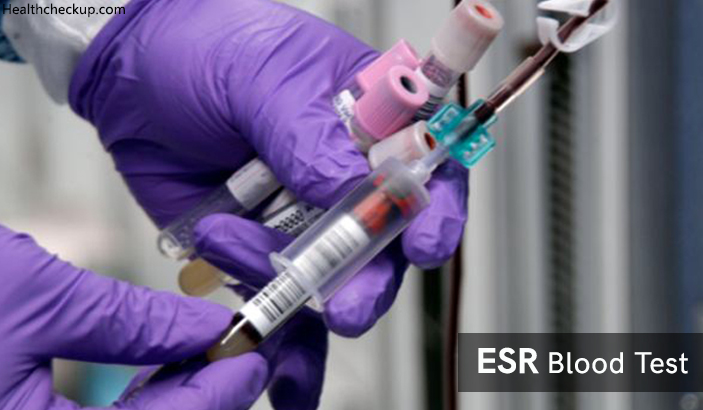The ESR test is done to check the presence of a disease, infection, or any other condition that is causing inflammation in the body. ESR stands for Erythrocyte Sedimentation Rate, and the test is also referred to as the Sedimentation Rate or “Sed Rate” in clinical settings. An ESR test is not a stand-alone test, and it may be used with other diagnostic tests to diagnose or monitor the progress of any inflammatory disease affecting the body.
The test for sed rate is a simple, inexpensive, but non-specific test that has been used for many years in the medical field to detect inflammation in the body caused by various conditions such as infection, cancer, or an autoimmune disease such as Systemic Lupus e\Erythematosus (SLE).
The sedimentation rate test is said to be a non-conclusive blood test because though an elevated ESR level indicates the presence of inflammation in the body, it does not directly point to the site of the inflammation or the cause for it. Due to these reasons, the ESR test is done along with other investigations to arrive at a diagnosis of the disease causing the inflammatory condition in the body. However, once the disease is diagnosed, a doctor may rely on the sed rate alone to monitor the progress of the disease and to look for the effectiveness of the treatment being given to the patient.
When is the Test Ordered by the Doctors?
A doctor usually orders an ESR to be done if you have the following Symptoms that suggest an Underlying Inflammatory Disease
- Headaches
- Joint stiffness
- Pain in the shoulders, neck, or the pelvis
- Anemia
- Loss of appetite
- Unexplained weight loss
Diseases Diagnose By ESR Test
The sedimentation rate test along with other specific diagnostic tests will help the doctor diagnose one of the following diseases
- A severe infection
- Cancer
- Giant Cell Arteritis: A condition which is characterized by a swelling in the lining of the blood vessels
- Systemic Lupus Erythematosus: An autoimmune disease that causes severe damage to the skin, joints, and other parts of the body
- Polymyalgia Rheumatic: An inflammatory disorder that usually causes muscle pain and stiffness, particularly in the shoulders
- Rheumatoid Arthritis: Another autoimmune disorder in which the body’s immune system, which usually fights bacteria and viruses and keeps the body healthy, mistakenly attacks and causes harm to the joints in the body
- Systematic Vasculitis: A condition characterized by the inflammation of the walls of the blood vessels; this condition may affect any blood vessels in any organs, thus causing a broad spectrum of signs and symptoms
- Temporal Arteritis: A condition in which the temporal arteries, or the arteries which supply blood to the head and brain, become inflamed and get damaged, causing symptoms such as a headache, jaw pain, and vision problems
The doctor may also order the test repeatedly once you have been diagnosed with any of the above diseases to observe how well your body is responding to the treatment being given or if the disease is getting worse.
How to Prepare for ESR Test
The ESR test is a simple blood test, and it doesn’t require much preparation on the part of the patient. You don’t need to fast before the test, but it is very important to verify with your doctor if you can take the regular medication you are on, on the day of the test, because some drugs may affect the results of the test. You should also let the doctor know if you are pregnant or if you’re on your period.
ESR Test Procedure
In the lab, a nurse or a lab technician will take a blood sample mostly from a vein in your arm. A band will first be tied around the upper part of the arm, to ensure the vein is filled with blood and is swollen up. Then the area is cleaned with an antiseptic, and a needle is placed in the vein to draw blood. You might feel a slight stinging sensation when the needle is placed, but it lasts only for a little while. The blood sample is collected in a vial or a tube, and the needle is removed when enough blood is collected.
The whole process takes only a few minutes, and a bandage is placed over the area where the needle was inserted to stop the bleeding. The blood sample collected is then sent to the lab for testing.
How is the ESR Determined?
In the laboratory, the blood sample collected is placed in a tall, thin tube, and the red blood cells or erythrocytes slowly settle to the bottom of the tube. An inflammation in the body, however, causes the red blood cells to clump due to the presence of abnormal proteins in the blood, and since these clumps are denser than the individual cells, they will settle to the bottom more quickly.
The ESR test measures the distance by which the red blood cells fall to the bottom of the tube in one hour. The greater the descent of the red blood cells, the greater the inflammatory response of the body is considered to be.
The result of the ESR test is reported as the millimeters of the clear fluid, i.e., the blood plasma, present in the top portion of the tube after one hour. The ESR is thus measured in millimeters per hour or mm/hr.
Interpretation of ESR Test Results
Normal Range For ESR
The ESR blood test normal range among men and women of different ages are as follows:
- 0 to 15 mm/hr in men who are younger than 50 years of age
- 0 to 20 mm/hr in men aged more than 50
- 0 to 20 mm/hr in women younger than 50 years of age
- 0 to 30 mm/hr in women aged above 50
What Does a High ESR Mean?
A test result higher than the normal ESR values may be indicative of an autoimmune disorder such as
- Rheumatoid Arthritis
- Giant Cell Arteritis
- Polymyalgia Rheumatic
- Systemic Lupus Erythematosus
- Allergic or Necrotizing Vasculitis
Some kinds of infection may also cause the ESR to rise, and these include
- Infection of the heart including that of the heart valves
- Skin infection
- Rheumatic Fever
- Bone infection
- Any systemic infection
- Tuberculosis
What Does a Lower ESR Mean?
An ESR lower than the usual range is usually not considered a threat to one’s health, however, a very low ESR value may indicate that the person tested may be suffering from one or more of the following conditions
- Sickle Cell Anemia
- Congestive Heart Failure
- Polycythemia
- Leukocytosis
- Liver or kidney diseases that lower the amount of plasma protein
A number of Conditions other than Inflammatory Diseases could affect your ESR Test Results. These Factors Include
- Advanced age
- Anemia
- Pregnancy
- Kidney diseases
- Obesity
- Thyroid dysfunction
- Infection
- Drugs like birth control pills, methyldopa, Vitamin A, quinine and cortisone
So, a good doctor will take into account these complicating factors when interpreting your test results.
Other Tests that the Doctor could Order
As mentioned earlier, an ESR test is non-specific and non-conclusive, because it only indicates an inflammatory condition in the body, but does not specify where the inflammation is, and what is causing it. Therefore, your doctor will use the test results along with other tests for inflammation such as the C-reactive protein test to arrive at a diagnosis.
Medically Reviewed By

I am an experienced Medical/Scientific writer with a passion for helping people live a happy healthy life. My thirst for writing has followed me throughout the years – it is there when I wake up, lingering at the edges of my consciousness during the day, and teases me at night as I go to sleep.











